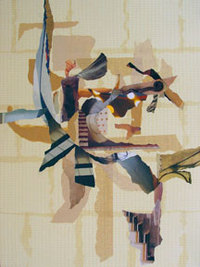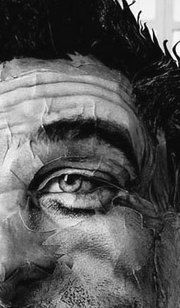 I saw the Alvin Ailey American Dance Theater today. What an amazing performance. So many effortless looking movements and intriguing choreography, amazing artistry and athleticism. I kept thinking how great it would be to photograph the dancers, even though it would be a blur, and use some of those abstract qualities as the basis for a collage composition. I have several pieces that I feel were influenced by my daughter's ballet studies. They are more carefully composed and balanced, as ballet tends to be. The photo shows a piece called "Arabesque" that was done quite some time ago. It would be fun to try something along those lines that incorporates more movement and speed. It is great when one kind of art is able to lend ideas to another kind of medium -- it was a very inspiring afternoon.
I saw the Alvin Ailey American Dance Theater today. What an amazing performance. So many effortless looking movements and intriguing choreography, amazing artistry and athleticism. I kept thinking how great it would be to photograph the dancers, even though it would be a blur, and use some of those abstract qualities as the basis for a collage composition. I have several pieces that I feel were influenced by my daughter's ballet studies. They are more carefully composed and balanced, as ballet tends to be. The photo shows a piece called "Arabesque" that was done quite some time ago. It would be fun to try something along those lines that incorporates more movement and speed. It is great when one kind of art is able to lend ideas to another kind of medium -- it was a very inspiring afternoon.
Inspiration
Violets
Reconstructing Imagery
 Last Thursday I went to a meeting of the Open Shelf Book Club at the Museum of Contemporary Art | Denver. Jasper de Beijer was discussing books and media that have influenced his work, now on view in the museum's Paper Works Gallery. The book he selected for our discussion next time is Journey to the End of the Night by Louis-Ferdinand Celine... he talked about the one-dimensional thinking it exposes and mentioned that it is a somewhat difficult read. He said it was like "staring into the abyss of the soul..."
Last Thursday I went to a meeting of the Open Shelf Book Club at the Museum of Contemporary Art | Denver. Jasper de Beijer was discussing books and media that have influenced his work, now on view in the museum's Paper Works Gallery. The book he selected for our discussion next time is Journey to the End of the Night by Louis-Ferdinand Celine... he talked about the one-dimensional thinking it exposes and mentioned that it is a somewhat difficult read. He said it was like "staring into the abyss of the soul..."
Several of us went up to the gallery afterwards and saw the show. His work is amazing. It was great to be able to ask him questions about his process. He builds representations of something that interests him and that he has studied -- using digital imagery, modelling, and some collage techniques -- and then photographs the models. Some of his models are on display along with a lot of the photographs. I was most taken with a series of 3-dimensional heads that he had collaged imagery onto -- busts of men who had suffered shell shock in WWI. The patched-together, collaged, 3D heads are quite interesting themselves but the photographic treatment flattens the imagery and really conveys their wounds and emptiness. The photo at top left is a detail from one of the heads to show how the imagery is joined... he said he mostly uses spray adhesive. If you click here, you can see his body of work and the larger image this detail comes from.
He talked a lot about our dis-association with photographed images from history. "...de Beijer has been reconstructing imagery that has become autonomous in the course of history, using existing sources to create a new reality." So then, what is "real"?
Building Creative Businesses
I went to Denver's Building Creative Businesses Expo on Saturday, attending sessions that covered Alternative Marketing Approaches for Artists and Working with Others on Public Art Projects. The third session I had selected was a bust so I slipped into a session for mid-career artists who want to work with multiple galleries. I got a lot out of hearing that discussion, information to be stored for future reference.
I particularly liked hearing artists discuss their marketing experiences -- what worked for them and what didn't. I got an infusion of good new ideas. And some inspiration to boot.

